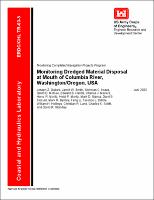Please use this identifier to cite or link to this item:
https://hdl.handle.net/11681/7621| Title: | Monitoring dredged material disposal at mouth of Columbia River, Washington/Oregon, USA |
| Authors: | United States. Army. Corps of Engineers. Portland District SonTek, Inc. O.H. Hinsdale Wave Research Laboratory Gailani, Joseph Z. Smith, Jarrell W. Kraus, Nicholas C. McGee, David D. Hands, Edward B. Mayers, Charles J. Moritz, Hans R. Moritz, Heidi P. Siipola, Mark D. Slocum, Daryl B. Byrnes, Mark R. (Mark Richard) Li, Feng Dibble, Terence L. Hollings, William H. Lund, Christian R. Sollitt, Charles K. Standley, David R. |
| Keywords: | Columbia River mouth Currents Dredged material disposal Dredged material FATE models Dredging Hazardous waves Numerical modeling Ocean dredged material disposal sites (ODMDS) Ocean data collection Predictive techniques Sediment dispersion Site capacity of ODMDS |
| Publisher: | Coastal and Hydraulics Laboratory (U.S.) Engineer Research and Development Center (U.S.) |
| Series/Report no.: | ERDC/CHL TR ; 03-5. |
| Description: | Technical report The entrance channel at the Mouth of the Columbia River requires annual dredging of 3 to 5 million cu m (3.9 to 6.5 million cu yd) of fine-to-medium sand to maintain the navigation channel at the authorized depth. The sandy dredged material is placed in EPA- approved Ocean Dredged Material Disposal Sites (ODMDS). Exceedance of ODMDS capacity at the Mouth of the Columbia River creates two operational problems for the Portland District: (a) The overall footprint of disposed dredged material extends beyond the existing ODMDS formally permitted boundaries by as much as 915 m (3,000 ft) in some cases, and (b) dredged material within the ODMDS has accumulated to such an aerial and vertical extent that adverse sea conditions are created. In some cases, mounds rise 18.3 to 21.4 m (60 to 70 ft) above surrounding bathymetry. Mariners report that the ODMDS mounds cause waves to steepen and/or break in the vicinity of the sites, and that these waves conditions are hazardous to navigation. The objectives of the MCNP monitoring at the Mouth of the Columbia River were to: (a) analyze existing data to document historic bathymetric response at the Mouth of the Columbia River entrance and the ODMDS due to anthropogenic and environmental conditions at the Mouth of the Columbia River; (b) monitor selected Mouth of the Columbia River ODMDS locations to observe bathymetric response with respect to dredging disposal operations and the forcing environment; (c) explain qualitatively and quantitatively the rates of sediment dispersion at the Mouth of the Columbia River ODMDS, and relate observed sediment dispersion of ODMDS citing and management practice; (d) Assess the suitability of new USACE Dredging Research Program sediment fate models (STFATE, LTFATE, and MDFATE) and RCPWAVE, and synthetically-generated input data from HPDPRE, HPDSIM, and ADCIRC for predicting sediment dispersion in the environment off the Mouth of the Columbia River; and (e) Develop a standardized method for data collection and management that can be used by other Corps District offices using as ODMDS. The FATE models had previously suffered from a lack of quality field data for their calibration and verification. As the new MCNP data were being acquired and processed, enhancements to the FATE models were incorporated to ensure these models would accurately predict the ultimate disposition of future dredged material disposal at such exceedingly energic locations. Finally, predictive techniques for determining sediment transport processes under both waves and currents were developed to assess the movement of disposed material at the Mouth of the Columbia River for assessing capacity and to determine the useful life of the ODMDS. The MCNP Mouth of the Columbia River study approach consisted of the execution of four fundamental tasks: (a) a regional coastal processes analysis, (b) oceanographic field data collection and analysis, (c) state-of-the-art numerical modeling, and (d) a comprehensive analysis of sediment transport processes. |
| Rights: | Approved for public release; distribution is unlimited. |
| URI: | http://hdl.handle.net/11681/7621 |
| Appears in Collections: | Technical Report |
Files in This Item:
| File | Description | Size | Format | |
|---|---|---|---|---|
| TR-CHL-TR-03-5.pdf | 15.39 MB | Adobe PDF |  View/Open |